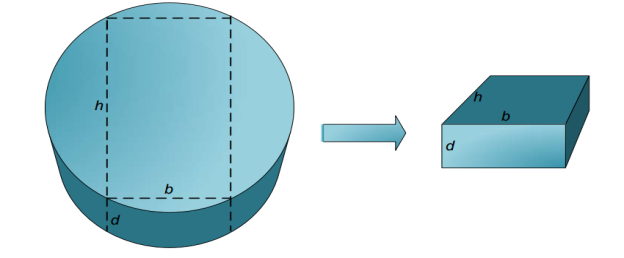Investigation of Tensile Strength
Direct tension is another method to categorize fatigue cracking. In this test procedure, tensile strength is measured in terms of tensile stress and tensile strain. Tensile stress is basically the resistance to fracture damage and tensile strain at maximum load is the ductility potential. In this testing procedure uniaxial tension is applied on the specimen. A cylindrical specimen is required having a 4 inch (100 mm) diameter and 6 inch (150 mm) or 4 inch (100 mm) height.(Walubita et al., 2011). The load is usually monotonically increasing at loading rate is 0.05 in./min (1.3 mm/min) at 77°F . (Walubita et al., 2005). For direct tension test specimen were compacted in the Superpave Gyratory Compactor having the mold height of 6.9 in (175 mm) in and a diameter of 5.9 in (150 mm) diameter. Sample is then put for curing for 24 hours and after that, it needs to be glued to the testing device carefully before running the test. Load, vertical displacement, and time, these are the three data that is obtained from the test.
For the DT test the tensile stress can be computed as
σt= P/(πr2)=P/πD2/4
Where σt=Minimum tensile stress; p=load; r=specimen radius & D= specimen diameter (Dissertation & Walubita, 2006)
And the tensile strain at maximum axial load can be computed as εt=10^6v/h ; εt=average axial tensile strain, V= average axial specimen deformation & h= specimen height. This way, HMA stiffness can be obtained as St= σt/εt, where St=Young’s Modulus (Stiffness); σt= Tensile stress (Maximum) & εt= Tensile strain at maximum axial load.
(Walubita et al., 2005), suggested σt>=65 psi & εt=< 3180 με , as the threshold for laboratory HMA crack resistance. They also found out that, increased binder content infact provide better resistance against fatigue cracking. Wen (2003), on the other hand, considered the fracture energy which is the area under the stress strain curve.
(Lytton, 2012) discussed about the procedure of testing field cores for direct tension. After getting the rectangular sample form the cylindrical field core, having length of 4 inch (102mm) and width of 3 inch (76 mm) and thickness of 1.5-3 inch (38-76 mm). As a steel cap is needed to be glued to the each specimen end, the authors used a special gluing jig to keep the specimen centrally aligned with the cap.


In total six LVDT’s were attached to measure the vertical and horizontal displacement at top, bottom and center layers. The authors run the test in different temperatures (10°C & 20 °C) in electro hydraulic servo machine (MTS) with a feedback frequency of 2Hz (done in an old machine) & 20Hz (done in a new machine).
Figure 2: Test setup with LVDT arrangement ((Lytton, 2012)
Dissertation, A., & Walubita, L. F. (2006). Comparison of Fatigue Analysis Approaches for Predicting Fatigue Lives of Hot-Mix Asphalt Concrete ( Hmac ) Mixtures Comparison of Fatigue Analysis Approaches for Predicting Fatigue Lives of Hot-Mix Asphalt Concrete ( Hmac ) Mixtures. Analysis, (May).
Lytton, R. (2012). Analytical-Numerical Methodology To Measure Undamaged , Fracture and Healing Properties of Asphalt Mixtures, (December).
Walubita, L. F., Jamison, B. P., Das, G., Scullion, T., Martin, A. E., Rand, D., & Mikhail, M. (2011). Search for a Laboratory Test to Evaluate Crack Resistance of Hot-Mix Asphalt. Transportation Research Record: Journal of the Transportation Research Board, 2210(1), 73-80. https://doi.org/10.3141/2210-08
Walubita, L. F., Martin, A. E., Jung, S. H., Glover, C. J., Chowdhury, A., Park, E. S., & Lytton, R. L. (2005). Project Title : Evaluate the Fatigue Resistance of Rut Resistance Mixes . URL : http://tti.tamu.edu/documents/0-4468-1.pdf. Security, 7(2).
References:
 Dissertation, A., & Walubita, L. F. (2006). Comparison of Fatigue Analysis Approaches for Predicting Fatigue Lives of Hot-Mix Asphalt Concrete ( Hmac ) Mixtures Comparison of Fatigue Analysis Approaches for Predicting Fatigue Lives of Hot-Mix Asphalt Concrete ( Hmac ) Mixtures. Analysis, (May).
Lytton, R. (2012). Analytical-Numerical Methodology To Measure Undamaged , Fracture and Healing Properties of Asphalt Mixtures, (December).
Walubita, L. F., Jamison, B. P., Das, G., Scullion, T., Martin, A. E., Rand, D., & Mikhail, M. (2011). Search for a Laboratory Test to Evaluate Crack Resistance of Hot-Mix Asphalt. Transportation Research Record: Journal of the Transportation Research Board, 2210(1), 73-80. https://doi.org/10.3141/2210-08
Walubita, L. F., Martin, A. E., Jung, S. H., Glover, C. J., Chowdhury, A., Park, E. S., & Lytton, R. L. (2005). Project Title : Evaluate the Fatigue Resistance of Rut Resistance Mixes . URL : http://tti.tamu.edu/documents/0-4468-1.pdf. Security, 7(2).
- Wen, H., “Investigation of Effects of Testing Methods on Characterization of Asphalt
Concrete,” Journal of Testing and Evaluation, Vol. 31, No. 6, pp. 1-7, 2003.